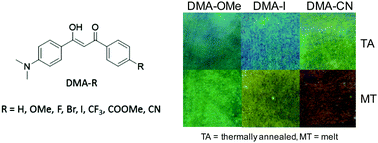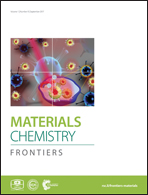Controlling solid-state optical properties of stimuli responsive dimethylamino-substituted dibenzoylmethane materials†
Abstract
The mechanochromic luminescent (ML) properties of boron coordinated β-diketones (BF2bdks) have been widely studied, however the stimuli responsive properties of uncoordinated β-diketones (bdks) are less known. While bdk dyes show promising properties, including high contrast ML, rapid room temperature self-erasure, solvatochromism, and aggregation induced emission (AIE), previously reported dyes exhibit emission over a narrow range of wavelengths (∼420–500 nm). To tune luminescence over a broader color range, dimethylamino (DMA) substituted β-diketones were synthesized with a series of electron donating and withdrawing substituents. Solvatochromism, aggregation induced emission (AIE), ML, and thermochromism were investigated. Most dyes showed positive solvatochromic shifts and were responsive to mechanical and thermal stimuli. The solid-state emission wavelengths correlated with the electron withdrawing strength of the para substituent and ranged from blue to orange (488–578 nm). Structural and thermal characterization was performed by powder X-ray diffraction (XRD) and differential scanning calorimetry (DSC) respectively. These data indicate that stimuli responsive properties are the result of a crystalline to amorphous phase transition. Additionally, the aggregation induced emission (AIE) properties of iodo and cyano substituted dyes were measured in THF/H2O solutions. Both showed intense emission resulting from aggregation. The sensitivity of these dyes toward matrix polarity was further investigated by fabricating polystyrene films with increasing concentrations of dye and camphoric anhydride, a non-emissive polar dopant. A red-shift in emission was observed in these films which demonstrated that matrix effects can be used to tune the emission of DMA-substituted diketones.

- This article is part of the themed collections: Celebrating Excellence in Research: 100 Women of Chemistry, Celebrating Excellence in Research: Women at the Frontiers of Chemistry, Materials Chemistry Frontiers HOT articles for 2017 and Aggregation-Induced Emission


 Please wait while we load your content...
Please wait while we load your content...